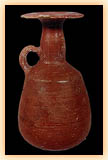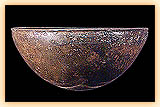
The Phoenicians, a people of Semitic origin, were organized in self-governed cities, which extended from Ugarit in the north to Jaffa in the south, in the strip of land known as the Levant in the eastern Mediterranean. The advantageous position of ancient Phoenicia on the geophysical map of the Middle East, as well as the insufficiency of its agricultural production pushed its inhabitants to the sea and trade. According to Hebraic sources (Kings 9 and 10), the Phoenicians had formed a considerable fleet and were already known for their seafaring skills from the beginning of the 10th century BC.
 Greece attracted the interest of the Phoenicians, as an area where
they could exchange various goods with natural and manufactured products
existing there. Before the end of the 9th century BC there are traces
of Phoenician presence in Crete and the Dodecanese, as well as
Greek products reaching the Middle East. At approximately the same time, according
to archaeological finds, the Phoenicians settled in Cyprus founding
their first overseas colony, around 820 BC, at Citium on the southeastern coast
of the island. More Phoenician settlements were added to this during the
8th century BC.
Greece attracted the interest of the Phoenicians, as an area where
they could exchange various goods with natural and manufactured products
existing there. Before the end of the 9th century BC there are traces
of Phoenician presence in Crete and the Dodecanese, as well as
Greek products reaching the Middle East. At approximately the same time, according
to archaeological finds, the Phoenicians settled in Cyprus founding
their first overseas colony, around 820 BC, at Citium on the southeastern coast
of the island. More Phoenician settlements were added to this during the
8th century BC.  During
this time, both Greeks and Phoenicians travelled and traded in the
central and eastern Mediterranean, whereas the latter had, in addition,
become active in areas to the west of Corsica and Sardinia.
The expansion of the Phoenicians in the western Mediterranean is proven by traces
of their settlements in various sites of the Iberian peninsula at the beginning
of the century and north Africa, Sicily, Sardinia and Malta from the mid-century
onwards. At the same time, however, the settlement of Greeks in
the central Mediterranean began, first with the foundation of Pithecussae
on the island of Ischia in the bay of Naples around the mid-8th century BC, and
next with a series of colonies in the eastern part of Sicily and southern
Italy.
During
this time, both Greeks and Phoenicians travelled and traded in the
central and eastern Mediterranean, whereas the latter had, in addition,
become active in areas to the west of Corsica and Sardinia.
The expansion of the Phoenicians in the western Mediterranean is proven by traces
of their settlements in various sites of the Iberian peninsula at the beginning
of the century and north Africa, Sicily, Sardinia and Malta from the mid-century
onwards. At the same time, however, the settlement of Greeks in
the central Mediterranean began, first with the foundation of Pithecussae
on the island of Ischia in the bay of Naples around the mid-8th century BC, and
next with a series of colonies in the eastern part of Sicily and southern
Italy.  The
relations between Greeks and Phoenicians were not confined only to the sector of trade.
Cultural influences were equally important. Since the lifestyle of the Phoenicians
was particularly enriched with elements of other eastern peoples,
the Greeks came into contact with the whole range of cultures of the Middle
East and not simply with the achievements of a single ethnic group. The
most important consequence of the contact of the Greeks with Phoenicians, though
(not only for Greek but for European history as well), was the adoption of the
Phoenician alphabet by the Greeks who, adjusting it to the demands of their
language, created the first phonetic alphabet.
The
relations between Greeks and Phoenicians were not confined only to the sector of trade.
Cultural influences were equally important. Since the lifestyle of the Phoenicians
was particularly enriched with elements of other eastern peoples,
the Greeks came into contact with the whole range of cultures of the Middle
East and not simply with the achievements of a single ethnic group. The
most important consequence of the contact of the Greeks with Phoenicians, though
(not only for Greek but for European history as well), was the adoption of the
Phoenician alphabet by the Greeks who, adjusting it to the demands of their
language, created the first phonetic alphabet.